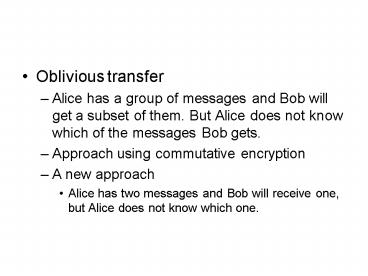Oblivious transfer PowerPoint PPT Presentation
1 / 15
Title: Oblivious transfer
1
- Oblivious transfer
- Alice has a group of messages and Bob will get a
subset of them. But Alice does not know which of
the messages Bob gets. - Approach using commutative encryption
- A new approach
- Alice has two messages and Bob will receive one,
but Alice does not know which one.
2
- Oblivious transfer
- Alice generates two public/private key pairs and
gives both public keys to Bob - Bob generates a symmetric key K, and randomly
selects one public key to encrypt and sends back
to Alice - Alice does not know which private key to use. So
she decrypts with both, gets K and K - She uses K to encrypt one message and K to
encrypt the other - At the very end, both sides need to reveal the
keys to show they do not cheat (what Alice can
do, what Bob can do)
3
- Oblivious transfer
- Can Alice cheat encrypt the same message with
two different keys - Can Bob cheat Bob cannot figure out the other key
4
Application of oblivious transfer
- Simultaneous contract signing
- Alice and Bob have agreed a contract and both
want to sign, but no one wants to go first. What
can we do? - A solution using TTP
- Each side signs a copy and gives to TTP
- Now both sides can sign.
- If any disagreement happens, TTP holds a copy
with your signature
5
- Simultaneous contract signing using baby steps
- Keep the difference between the degrees of
commitment from both sides a very small value - Each side signs a letter and switch
- Each side signs with an increasing commitment
level
6
- A real simultaneous contract signing protocol
using oblivious transfer - Possible attacks
- Can Alice sends garbage bits during OT? For a
specific pair, Alice has 50 chance to cheat.
With all n pairs, Alices chance decreases to
(½)n - Alice can send fake keys. But she does not know
which keys Bob has, so she will be caught if she
cheats.
7
- Possible attacks to simultaneous contract signing
using OT - Alice can control which keys Bob receives through
OT by encrypting the same message with different
keys. But Bob can bring these messages to court. - Assumptions of the protocol
- Both sides have roughly the same computation
capability - There is no deadline approaching
8
- Digital certified mail using OT
- Alice sends an email to Bob, she wants a signed
receipt before Bob can read it. - It looks similar to the contract signing
protocol, but not really - Can Alice sends halves of email to Bob?
- Can Alice encrypts the email and send halves of
the keys to Bob? - Keys are just random numbers, how can Bob make
sure these halves are real keys but not some
garbage? On the contrary, Alice can examine the
halves of the receipt during OT.
9
- Improved digital certified mail
- Simultaneous exchange of secret
- The secret can be viewed as the email in previous
protocol - Both sides XOR the keys to recover the message at
the very end
10
(No Transcript)
11
- Secure elections Maintain privacy and prevent
cheating - A voting method needs the following properties
- Only authorized voters can vote
- No one can vote more than once
- No one can know for whom anyone else vote
- No one can change others vote
- A voter can verify whether his vote is counted
12
- A simple protocol
- Every one signs the vote with private key, then
encrypt with the centralized nodes public key - Only authorized voters can vote and no one can
vote twice - Violation to privacy
- A voting protocol using blind signature
- We need to separate the vote from the voter, and
keep the authentication, seems that blind
signature can do it. - Every node can only get the signed vote once,
- A malicious node cannot vote twice since the
votes will have the same identification number - CTF maybe knows who votes for whom (by tracing
the source of a vote), anonymous sending can
solve this problem - CTF can generate fake votes
13
- A self-organized voting protocol (removing the
centralized counter) - First , a bad protocol
- (1) Every node generates his vote and a random
number, then encrypts - E_pub-A (E_pub-B (E_pub-C (E_pub-D (vote,
random number)))) - (2) Every node sends the vote to Alice, who
will decrypt the first encryption, signs the
results, and shuffle the order. - (3) B, C, and D do the same
- (4) Finally, the (vote, random) plain texts
are revealed, and every node makes sure his vote
is counted. - What is the problem? Alice receives the original
packet. When she sees the final results, she can
recover the votes by encrypting with the public
keys and know who vote for whom
14
- A more complicated protocol
- A malicious node cannot insert, or change a vote
in round 2. All intermediate results are signed
and broadcasted to everyone - If the vote is changed in round 1
- If the node checks the votes after that, he will
immediately find the problem - Otherwise, he will wait till round 2 and still
find the problem - The random numbers and shuffle order together
prevent the reconstruction of the votes you
cannot figure out who voted for whom
15
- Problem of the self-organized voting protocol
- Too much computation overhead
- Alice can blindly duplicate others vote to see
who he/she votes for (three person example) - Need to examine the random number at the very end

